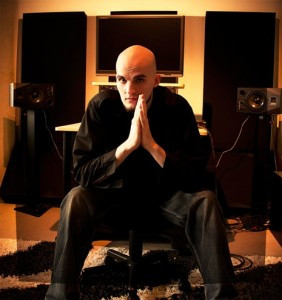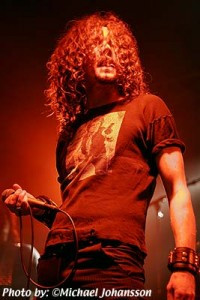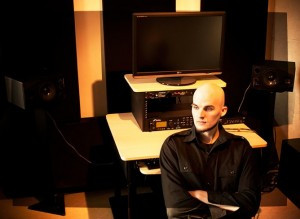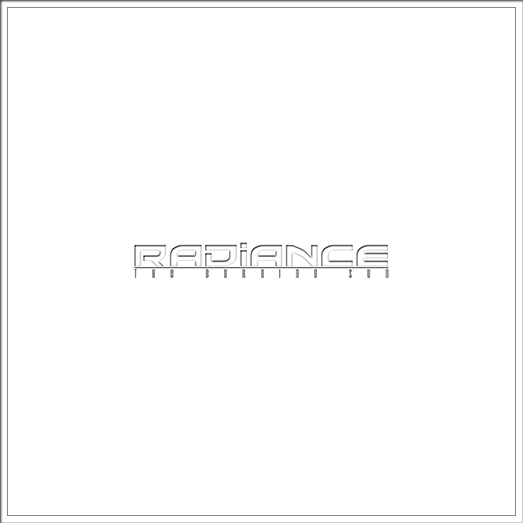[Following our posts on Akelei, Agalloth, and Hull, this is the fourth installment of our mini-series on longer-than-average songs from recent releases by some über-talented musicians.]
In the minds of the three co-founders of this site, Necrophagist occupies a golden throne in the pantheon of technical death metal. On our metallic island, we regularly sacrifice annoying children in their name while ritually reciting Beowulf passages from The Nowell Codex.
Among Necrophagist worshippers, the blazing technicality of frontman Muhammed Suiçmez is usually the center of attention. But he’s not the only guitar wizard in Necrophagist. Sami Raatikainen, the Finnish guitarist who joined the band in 2006 following the departure of Christian Muenzner (Obscura), is also a dextrous 7-string wonder to behold.
The extent of Necrophagist’s global following is amazing, given that the band has only produced two albums in the last 11 years, and that six years have elapsed since the second one (2004’s Epitaph). At one point, a new album was scheduled for release in the spring of this year, but that turned out to be a false hope, and there’s no current timetable for release of the third album.
Sami Raatikainen joined the band after Epitaph and therefore hasn’t added his name to the Necrophagist discography. But that doesn’t mean he’s been sitting around twiddling his thumbs since 2006. Far from it. In addition to touring with Necrophagist and working on the band’s own version of Chinese Democracy, Raatikainen has been putting in the weeks, the months, the years on his own side project, called Radiance.
The debut album from Radiance is now available. It’s called The Burning Sun. It sounds nothing like Necrophagist. It’s also one long song — 49 minutes worth of song. Part Iron Maiden, part Dream Theater, part Meshuggah, and almost all Sami, it’s a beautifully constructed, superbly executed work that’s worth the time required to hear it straight through. (more after the jump . . .)
 The Burning Sun is a concept album that Raatikainen has been working on since July 2007. The story of its evolution is as much a saga as the album itself is. Raatikainen recorded all the instrumental tracks himself, which include synthesizer orchestration in addition to multiple guitar tracks, bass, and drums. He finished the instrumental tracks in 2008, and then spent 6 months attempting to master the vocals himself, though so far as we know he hadn’t been a vocalist in his previous experience.
The Burning Sun is a concept album that Raatikainen has been working on since July 2007. The story of its evolution is as much a saga as the album itself is. Raatikainen recorded all the instrumental tracks himself, which include synthesizer orchestration in addition to multiple guitar tracks, bass, and drums. He finished the instrumental tracks in 2008, and then spent 6 months attempting to master the vocals himself, though so far as we know he hadn’t been a vocalist in his previous experience.
In his conception of the album, he wanted strictly clean singing, and used a Swedish vocalist named Mats Levén (KRUX, ex-THERION, ex-YNGWIE MALMSTEEN) as his model. Eventually, after those six months of effort, Raatikainen surrendered and approached Levén himself– and Levén agreed to record the vocals.
Raatikainen also recruited a female vocalist named Noora Häkkinen (NORADRENALINE) for the album. Ultimately, the vocals were recorded in 2009. Raatikainen spent 2010 entirely in post-production — working with 460 tracks of audio, mixing and mastering the music himself, in what he describes as “a tedious learning experience,” without a lot of previous practice on which to draw.
The album is now finished, after more than three years of effort. In its digital form, it’s divided into seven segments, but only to make it easier to jump from place to place after you’ve heard the whole thing — not because there are seven distinct songs or even seven distinct movements in a single work; the dividing lines within this long song aren’t that clear.
 The first segment — “Lambda 475” — is a synthesizer-driven, ambient-music introduction that moves into the second segment, “The Burning Sun”. That segment, as it’s demarcated on the album, is almost 19 minutes long. It moves from a Meshuggah-esque, machine-gun attack of riffage (combined with a blizzard of repeating electronic pulses) into the principal melodic theme of the album, as voiced by Levén and then elaborated upon in a piano interlude.
The first segment — “Lambda 475” — is a synthesizer-driven, ambient-music introduction that moves into the second segment, “The Burning Sun”. That segment, as it’s demarcated on the album, is almost 19 minutes long. It moves from a Meshuggah-esque, machine-gun attack of riffage (combined with a blizzard of repeating electronic pulses) into the principal melodic theme of the album, as voiced by Levén and then elaborated upon in a piano interlude.
This long passage includes significant changes of speed, moments of near-quiet, two blazing guitar solos, intermittent keyboard ambience, and more of that cathartic, staccato riff-work, and lots of dramatic vocalization by Mats Levén.
This long segment is followed by another passage of ghostly keyboard ambience (“Lambda 610”), segueing into an entrancing interlude of solitary piano chords, wordless vocals from Noora Häkkinen, and eventually the slow, power-metal vocals of Mats Levén — drawing the music almost to a dead stop, followed by an outro consisting of the sound of waves washing up and back on a beach.
The peace is only temporary, because the next segment (“Downward Spiral”) is the musical match of “The Burning Sun”. It’s more than 14 minutes long. It leads with massive, plodding chords and blasting drums, and starbursts of lead guitar. Synthesized strings trade places with assault-weapon riffing and headbanging progressive metal, and dozens of other instrumental details, as Levén weaves a variety of vocal melodies.
“Lambda 690” creates a pause in the music with another atmospheric keyboard instrumental, symphonic and slow and moody.
 The last segment of the album, fittingly, is called “Conclusion”. It reaches back into “The Burning Sun” and pulls forward the staccato rhythms, the pulsating electronica, the synthesized ambient atmosphere, the melodies of that phase of the album. This is one of the very few places in the album where Levén’s vocals dip down low and almost raspy. Near the end, a slow piano melody consumes the song, with Noora Häkkinen’s wordless vocals adding an ethereal beauty to the sound.
The last segment of the album, fittingly, is called “Conclusion”. It reaches back into “The Burning Sun” and pulls forward the staccato rhythms, the pulsating electronica, the synthesized ambient atmosphere, the melodies of that phase of the album. This is one of the very few places in the album where Levén’s vocals dip down low and almost raspy. Near the end, a slow piano melody consumes the song, with Noora Häkkinen’s wordless vocals adding an ethereal beauty to the sound.
You know that when we write about music, we like to let you listen, too. Mere words can never fully capture sounds, and especially not our mere words. But featuring a selection of music from The Burning Sun is difficult. The album wasn’t meant to be heard in pieces, and finding a segment to stream is sort of like ripping out an organ from a larger organism and asking you to imagine the whole from a part that was never meant to be considered by itself.
But, of course, that didn’t stop us. Because, to decide if this is your cuppa tea, you need to hear something. So, what we did was to use editing software to carve out a segment within a segment — the first 14:06 of that piece-of-the-whole second “track” called “The Burning Sun”. Even our slice of this album is long, though shorter than the segment as it appears on the album. But choosing anything shorter wouldn’t be fair to the music. Check it out:
The Burning Sun can be streamed in its entirety, and downloaded for a minimum price, at Radiance’s Bandcamp page here. More information about the project is available at the official Radiance site, which includes Sami Raatikainen’s running blog entries.
Someday soon, we’ll get back to the kind of music for which this site was named — but today we’re hooked by this music. The Burning Sun is an intricate, engrossing work of metal which proves beyond doubt that Sami Raatikainen is a blazing force to be reckoned with. We hope you like it as much as we do.


i have been listening to this record now for a while and i really really like it.
its nice to listen to something that is DJENT, proggy and spacey but doesnt sound like every other djent band out there trying to emulate meshuggah/bulb/cloudkicker/animalsasleaders.
Exactly right — it’s got all those qualities, but a lot more besides — including some face-melting solos and Levén’s power-metal vocals (which I usually just can’t get into, but have grown on me the more I’ve listened to The Burning Sun).
Alright, I’ve got bandcamp loaded up and listening commenced, but I doubt I’ll actually finish the whole thing….
The longest…thing I’ve ever tried to listen to was Die Valkyrie…I think I got about 2/3rds through it before I had to do and listen to something else.
Wait. This is pretty awesome.
I mentioned Die Valkyrie, because when we talk about long songs, I feel like we’re kind of missing this whole segment of the music world that bends the idea of song and fucks dead. I also found your description of album more inline with how people describe an opera or a symphony than an album.
It’s like the difference between the Iliad and Ezra Pound’s In a Station of the Metro. I can appreciate both of them, but I find that, on a day to day basis, I prefer the shorter verses. And I refuse to blame this only on my pitiful attention span. I think there is a clear and distinct aesthetic difference…. Extreme metal of the kind we usually listen to here at NCS tends to be short and full of balls out impact. It’s the same with a short poem. You have to be fucking perfect with each syllable, each image. With a longer work, obviously you can’t get sloppy, but you do have a bit more leeway. You can build more and twist more and you can simply DO a lot more, but it doesn’t have that blast of a knee to the face that an explicitly shorter work does.
What the fuck did I just write? I think I took myself off topic.
TENTACLE VAGOO CUBE PORN!!!
I should note that Ezra Pound was just trying to rip off my beloved classical Japanese poetry, but that’s a story for another time.
Back to the octosquid orgy of 2010!!!
I just realized I made it all the way through!
I rather liked the music, but…I kind of wish he would have gotten a different male vocalist.
So many power metal singers sound like their straining to have emotion…instead of just emoting.
Or whatever.
Well, you know my prejudices. I think I understand why Sami wanted this kind of vocal style, given what he was doing with the music, but I think it also would have worked with non-clean vocals. Then again, it would have significantly altered the musical conception, because so many of the melodies are now voiced by Levens instead of the instruments.
I’m not categorically against cleaning singing. I actually love some power metal…
But I just hate the “I’m straining to show how deeply I’m feeling the lyrics” sound, which is what
the guy sounds like here…
In my case it’s all about the short attention span. 🙂 And the desire for balls-out impact. But I do think I’m missing out, and so am trying to rectify the deficiency, at least a little.
And thank you for going off-topic. Some day you’ll have to elaborate on Ezra pound and Japanese poetry. I had no idea there was any connection.
Ezra was more into Chinese poetry, as far as I know, but In a Station in the Metro is supposed to be a haiku.
I can’t really say if he succeeded or not, because I’m interested in an older form of Japanese poetry, but it’s an interesting note. Well, for me at least.
The Wikipedia analysis would suggest that he accomplished what he set out to do, but I think the linguistic differences between our languages really hampers efforts to write English in a Japanese style…at least in terms of poetry.
Though I’m more parroting far more learned scholars, so I’d be hard pressed to prove my point.
Though that’s the case for any language, isn’t it???
I haven’t gotten far yet and I need to head off to work in a bit, but I will make the effort to get through all of this later on today. If done right, songs this long (broken up or not) can work rather well. Mats Levén is an amazing singer, so getting to hear more from him is a treat. That a Finnish musician is behind this doesn’t hurt.